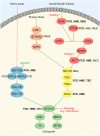Precision Therapy for Epilepsy Related to Brain Malformations
- PMID: 34608615
- PMCID: PMC8608994
- DOI: 10.1007/s13311-021-01122-6
Precision Therapy for Epilepsy Related to Brain Malformations
Abstract
Malformations of cortical development (MCDs) represent a range of neurodevelopmental disorders that are collectively common causes of developmental delay and epilepsy, especially refractory childhood epilepsy. Initial treatment with antiseizure medications is empiric, and consideration of surgery is the standard of care for eligible patients with medically refractory epilepsy. In the past decade, advances in next generation sequencing technologies have accelerated progress in understanding the genetic etiologies of MCDs, and precision therapies for focal MCDs are emerging. Notably, mutations that lead to abnormal activation of the mammalian target of rapamycin (mTOR) pathway, which provides critical control of cell growth and proliferation, have emerged as a common cause of malformations. These include tuberous sclerosis complex (TSC), hemimegalencephaly (HME), and some types of focal cortical dysplasia (FCD). TSC currently represents the best example for the pathway from gene discovery to relatively safe and efficacious targeted therapy for epilepsy related to MCDs. Based on extensive pre-clinical and clinical data, the mTOR inhibitor everolimus is currently approved for the treatment of focal refractory seizures in patients with TSC. Although clinical studies are just emerging for FCD and HME, we believe the next decade will bring significant advancements in precision therapies for epilepsy related to these and other MCDs.
Keywords: Epilepsy; Malformations of cortical development (MCDs); Mammalian target of rapamycin (mTOR); Precision therapy; Somatic mosaicism.
© 2021. The American Society for Experimental NeuroTherapeutics, Inc.
Figures


References
-
- Barkovich AJ, Kuzniecky RI, Dobyns WB, Jackson GD, Becker LE, Evrard P. A classification scheme for malformations of cortical development. Neuropediatrics. 1996;27:59–63. - PubMed
-
- Camfield P, Camfield C. Incidence, prevalence and aetiology of seizures and epilepsy in children. Epileptic Disord. 2015;17:117–123. - PubMed
-
- Hunter MB, Yoong M, Sumpter RE, et al. Incidence of early-onset epilepsy: A prospective population-based study. Seizure. 2020;75:49–54. - PubMed
Publication types
MeSH terms
Substances
Grants and funding
LinkOut - more resources
Full Text Sources
Medical
Miscellaneous

